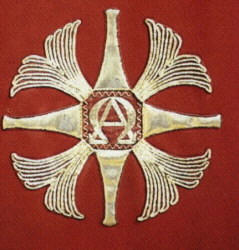 Isis in Egypt.
Astaroth. Father
Enki. Inanna came first, the goddess of
the Sumerians. Ishtar came after, the goddess of the Babylonians and Assyrians.]
Isis in Egypt.
Astaroth. Father
Enki. Inanna came first, the goddess of
the Sumerians. Ishtar came after, the goddess of the Babylonians and Assyrians.]
Inanna/Ishtar (Isis)
Symbols
Prostitution
 Isis in Egypt.
Astaroth. Father
Enki. Inanna came first, the goddess of
the Sumerians. Ishtar came after, the goddess of the Babylonians and Assyrians.]
Isis in Egypt.
Astaroth. Father
Enki. Inanna came first, the goddess of
the Sumerians. Ishtar came after, the goddess of the Babylonians and Assyrians.]
Symbols: Snake Asclepius & Caduceus Lion Dragon 8-point sun wheel Whore of Babylon Building symbology
Quotes
Astaroth
(also Ashtaroth, Astarot, and Asteroth), in demonology, is a Crowned Prince of
Hell. He is a male figure named after the Canaanite
goddess Ashtoreth. The name Astaroth was
ultimately derived from that of 2nd millennium BC Phoenician goddess Astarte,[1]
an equivalent of the Babylonian Ishtar, and the earlier Sumerian Inanna.
http://en.wikipedia.org/wiki/Astaroth
The name Ishtar is Semitic for the goddess Inanna of Sumeria.
sacred “prostitution” was part of the religion as Ishtar was the
courtesan of the gods”...Ishtar possessed a litany of
weapons and one of her totems was the lion...Ishtar
was called the Lady of Battles, the Queen of Attack, The Lady of Victory, Queen
of Hand-to-Hand Fighting and the Guardian of Law and Order; all linking her to
the planet Mars.
Again, in her aspect of Warrior
Queen, Ishtar held a labrys, scepter or a staff with either one or two snakes
coiled around it. In this aspect, the snake stood for the ability to take a
life. It seems that this staff/scepter started out
with only one snake and then ended up with two. The healing god Ningishzide,
who goes back to Mesopotamia, was a lover of Inanna/Ishtar. He carried a
single-serpent wand, but this snake had two heads and both male and female sex
organs in the one body. This kind of Mesopotamian snake was called a Sachan,
and was Ningishzide’s symbol. Regardless as to how
many snakes, there were, the staff, which became the healing caduceus of Hermes,
was a symbol of Inanna/Ishtar’s power to grant life, to heal, or to take life
away. Before it became the Greek caduceus, this staff had a solar disc on top
with two snakes that looked like horns (see below for “cow”). Later, Hermes
came to own the staff, by this time it had two snakes intertwined around it, and
this was his symbol as the Psychopomp, the Conductor of Souls.
Inanna/Ishtar was known as the Eye
Goddess and she had Eye Temples. One of the oldest of these Eye Temples, dating
back to about 3000 BCE, is at Tell Brak in eastern Syria. Found inside were
thousands of figurines of the Eye Goddess, each with staring, wide, owl-like
eyes which are coiled like snakes. It is thought that these eyes that stare are
eyes that see justice.
A larger version of the serpent,
Ishtar was shown with dragons by her sides when she was in her aspect of the
Goddess of War or when protecting her people. Inanna was one of the three main
deities involved with a major battle between good and evil. The evil was known
as he dragon Kur.
COWS
Like Isis and Hathor of Egypt and Io and Ionia, Inanna/Ishtar was a Cow
Mother Goddess. She, like Kybele/Cybele, was pictured with bovine horns or as
cows with lunar horns. Inanna/Ishtar, because of her association with the Moon,
is also linked to the horns of a bull. These bull horns also link her to
fertility, due to their similarity in shape to the fallopian tubes. Some myths
have Inanna/Ishtar giving birth to bulls or golden calves.
Let’s Spell it Out
Ishtar (a.k.a. Inanna in Babylon, Isis in Eygypt, Astarte or Aphrodite in Greece and Libertas/Venus in Rome to name just a few) http://www.bibliotecapleyades.net/esp_ishtar.htm
The destructive nature of the Canaanites upon other nations in which they
settled is nowhere more strongly demonstrated than in Egypt, the first land to
be corrupted by their barbaric practices. Originally, "Baal" simply meant Lord
in the Canaanite language. The obscenity of the rites soon developed a popular
image of
Baal
which had three heads, the head of a cat, the head of a man, and
the head of a toad. His wife, Ashtoreth, also known as Astarte and Ishtar, was
the principal goddess of the Canaanites. She also represented the reproductive
principle in nature, and in case anyone might overlook it, all of her rites were
sexual observances. In Babylon, the temples of Baal and Ashtoreth were usually
together. Mainly, they served as houses of prostitution, in which the
priestesses were prostitutes, and the male priests were Sodomites who were
available for the worshippers who were of that persuasion. The worship of the
Canaanite gods consisted of orgies, and all their temples were known as centers
of vice. They also originated voodoo ceremonies, which became the rites of
observance in Ethiopia through the Ethiopian Jethro, the tutor of Moses. These
same rites now enthrall tourists in the Caribbean.
It was not long before the simple ceremonies of vice began to pall on the
worshippers of Baal. They sought greater excitement in rites of human sacrifice
and cannibalism, in which the torture and murder of small children were
featured. To consolidate their power over the people, the priests of the
Canaanites claimed that all firstborn children were owed to their demon gods,
and they were given over for sacrifice. This lewd and barbaric practice was
noted in Isaiah 57:3-5:"But you, draw near hither, sons of the sorceress,
offspring of the adulterer and the harlot. Of whom 'are you making sport?
Against whom make ye a wide mouth, and draw out the tongue? Are ye not children
of transgression, a seed of falsehood? Inflaming yourself with idols under every
green tree, slaying the children in the valleys under the cleft of the rocks?"
Chapter 1: The War
Against Shem
Ishtar held a labrys, scepter or a staff with either one or two snakes coiled around it
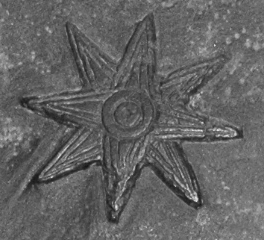
One version of the star symbol of Inanna/Ishtar
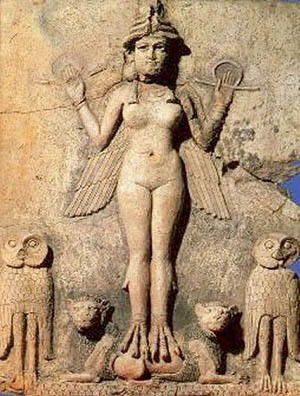
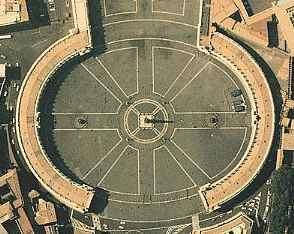
Obelisk So in St. Peter's square, the symbol of
Baal is within the symbol of Ishtar, and
at the center is an Egyptian obelisk, all representing pagan sun worship.
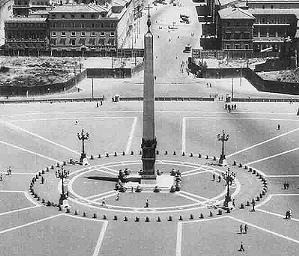
Here is an old photo of the center of St. Peter's square, and
note that around the obelisk, at the center of the huge eight-point sun wheel,
is a smaller four-pointed sun wheel, the same symbol as found on the altar stone
in the temple of Baal in Hatzor!
http://www.aloha.net/~mikesch/wheel.htm
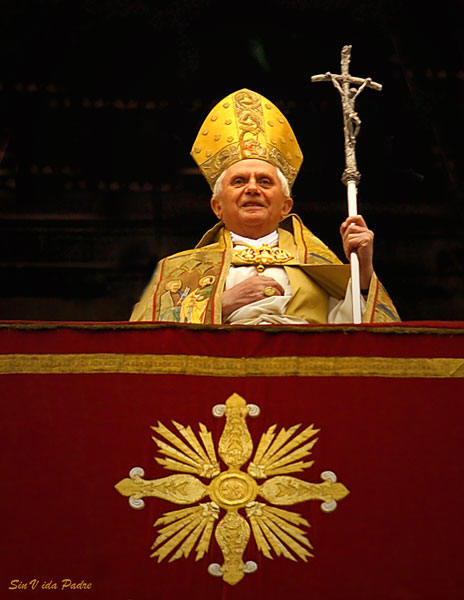

A decorative wheel found on the altar of a Roman Catholic church.
http://www.remnantofgod.org/images/IGC/pagan-rcc.htm
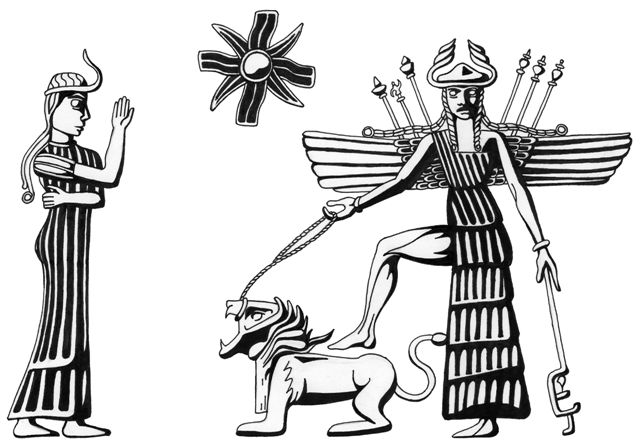
Triumphant Inanna-Ishtar, winged, with foot on
her roaring lion and star symbol, being worshipped by a lesser goddess.
Black-stone cylinder seal. Akkadian, ca. 2334-2154 BCE.
S. Beaulieu, after Wolkstein & Kramer
1983:92
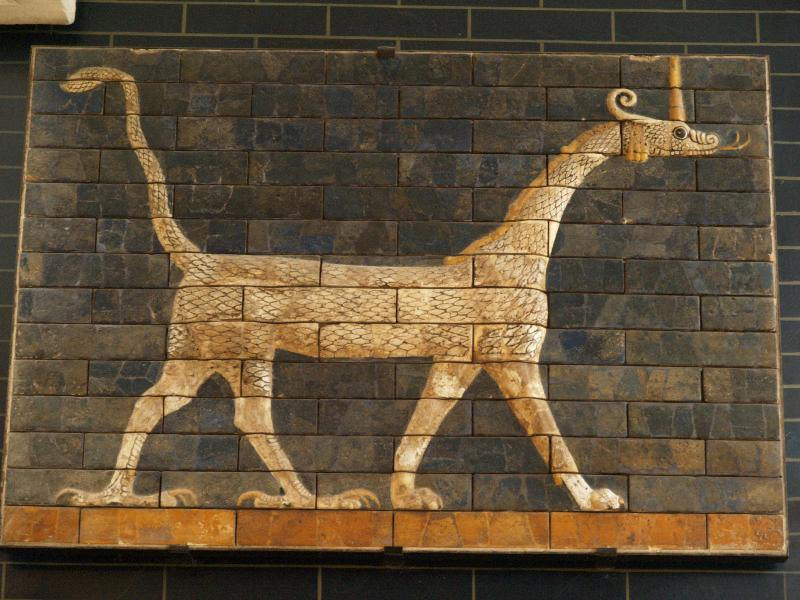
Istanbul, Turkey: Museum of the Ancient Orient: Ishtar Gate, dragon 'Mushushu'
panel (reconstructed, original was c 575 BC)